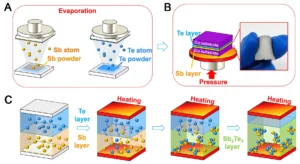In the world of materials science and physics, substances can be classified into various categories based on their magnetic properties. Understanding these classifications is crucial for various scientific and technological applications. In this article, we will explore different types of substances, including diamagnetic, paramagnetic, ferromagnetic, antiferromagnetic, and ferrimagnetic materials, along with their properties and examples.
Diamagnetic Materials:
Diamagnetic materials are characterized by the absence of any permanent magnetic moment. When placed in an external magnetic field, they develop a weak, negative magnetic moment. Diamagnetism arises due to the orbital motion of electrons within atoms. Some key properties of diamagnetic materials include:
Key Properties of Diamagnetic Substances:
- Weak Repulsion: Diamagnetic materials are characterized by a weak repulsion when placed in an external magnetic field. This repulsive force is a result of the induced magnetic moment opposing the applied field, causing the substance to be pushed away.
- No Intrinsic Magnetic Moment: Unlike paramagnetic and ferromagnetic materials, diamagnetic substances possess no intrinsic magnetic moment. This lack of inherent magnetisation is due to the complete pairing of electrons within the material.
- Magnetic Susceptibility: Diamagnetic susceptibility, a measure of the material’s response to an external magnetic field, is always negative. It quantifies the degree of diamagnetism, and for diamagnetic materials, this value is typically small and negative.
- Temperature Independence: Diamagnetism is generally independent of temperature. Unlike ferromagnetic materials, which may exhibit a Curie temperature leading to a change in magnetic behaviour, diamagnetic properties remain relatively consistent across different temperatures.
Examples of Diamagnetic Substances:
- Bismuth (Bi): Bismuth is a classic example of a diamagnetic material. When subjected to a magnetic field, it exhibits a weak repulsion.
- Graphite: Graphite, a form of carbon, is another diamagnetic substance. Its unique hexagonal lattice structure contributes to its diamagnetic behaviour.
- Copper (Cu): Copper is considered diamagnetic, although its diamagnetic susceptibility is quite small. The overall effect is weak repulsion when exposed to a magnetic field.
Applications and Significance:
- Magnetic Levitation: Diamagnetic materials can be used in magnetic levitation applications. When placed in a strong magnetic field, diamagnetic substances experience repulsion, leading to levitation. This principle has been employed in various research and demonstration setups.
- Materials Science Research: The study of diamagnetic materials is crucial in materials science research, helping scientists understand the fundamental magnetic properties of different substances.
- Medical Imaging: While not the primary choice for medical imaging, certain diamagnetic materials, when combined with other imaging techniques, can be useful in specific biomedical applications.
In conclusion, diamagnetic substances play a unique role in the realm of magnetic materials. Their weak repulsion and absence of intrinsic magnetic moment distinguish them from other magnetic classifications, and their properties find applications in diverse scientific and technological domains.
Paramagnetic Materials:
Paramagnetic materials have unpaired electrons, leading to the presence of a magnetic moment. When exposed to an external magnetic field, these materials align their magnetic moments in the direction of the field. Key properties of paramagnetic materials include:
Key Properties of Paramagnetic Substances:
- Unpaired Electrons: The hallmark of paramagnetism is the existence of unpaired electrons in the atomic or molecular orbitals of the substance. These unpaired electrons give rise to magnetic moments that can align with an external magnetic field.
- Weak Attraction: When placed in an external magnetic field, paramagnetic substances experience a weak attraction towards the field. This is a result of the alignment of the magnetic moments of the unpaired electrons in the direction of the applied field.
- Magnetic Susceptibility: Paramagnetic susceptibility, a measure of the material’s response to an external magnetic field, is positive and typically small. The positive value indicates a tendency to align with the external field.
- Temperature Dependence: Paramagnetism is temperature-dependent. As the temperature increases, the thermal motion of atoms or molecules may disrupt the alignment of magnetic moments, leading to a decrease in paramagnetic behaviour.
Examples of Paramagnetic Substances:
- Aluminium (Al): Aluminium is an excellent example of a paramagnetic material. Its paramagnetic behaviour arises due to the presence of unpaired electrons in its atomic structure.
- Platinum (Pt): Platinum exhibits paramagnetic properties, with its unpaired electrons contributing to the weak attraction when subjected to an external magnetic field.
- Oxygen (O2): Molecular oxygen is paramagnetic due to the presence of two unpaired electrons in its molecular orbitals. This property is utilized in the liquid oxygen enrichment process.
Applications and Significance:
- Magnetic Resonance Imaging (MRI): Paramagnetic substances are crucial in the field of medical imaging. Contrast agents containing paramagnetic elements enhance the visibility of specific tissues and structures in MRI scans.
- Material Sorting and Separation: In industrial processes, paramagnetic properties can be exploited for sorting and separating materials based on their response to magnetic fields.
- Magnetic Data Storage: Certain paramagnetic materials are used in magnetic data storage devices, contributing to the development of technology such as hard disk drives.
- Research in Chemistry and Physics: The study of paramagnetism plays a vital role in understanding electronic configurations and magnetic behaviours, contributing to advancements in chemistry and physics.
In conclusion, paramagnetic substances offer a fascinating glimpse into the intricate world of materials with unpaired electrons. Their weak attraction to magnetic fields has significant implications in various scientific, medical, and technological applications, making them a subject of continued research and exploration.
Ferromagnetic Materials:
Ferromagnetic materials exhibit strong magnetic properties and can retain a significant magnetic moment even in the absence of an external magnetic field. The magnetic moments of individual atoms align parallel to each other, resulting in macroscopic magnetisation. Key properties of ferromagnetic materials include:
- Definition: Ferromagnetism is a property displayed by materials that have a high magnetic permeability and can be easily magnetised. When exposed to an external magnetic field, ferromagnetic materials retain their magnetisation even after the external field is removed.
- Common Ferromagnetic Materials:
- Iron (Fe): One of the most well-known ferromagnetic materials. It is widely used in various applications, such as in the construction of magnets and magnetic cores in transformers.
- Cobalt (Co) and Nickel (Ni): These elements, along with iron, are part of the iron triad and also exhibit strong ferromagnetic properties.
- Some alloys and compounds: Certain alloys, such as alnico (aluminium, nickel, cobalt), and some compounds like magnetite (Fe3O4) also exhibit ferromagnetic behaviour.
- Atomic Origin: Ferromagnetism is primarily associated with the alignment of magnetic moments within the atoms of a material. In ferromagnetic substances, adjacent atomic magnetic moments tend to align parallel to each other, resulting in a macroscopic magnetic moment for the entire material.
- Spontaneous Magnetisation: Below a critical temperature called the Curie temperature (Tc), ferromagnetic materials undergo spontaneous magnetisation. At temperatures above Tc, thermal energy disrupts the alignment of magnetic moments, causing the material to lose its ferromagnetic properties.
- Hysteresis: Ferromagnetic materials exhibit hysteresis, which means that the magnetisation of the material depends not only on the current magnetic field but also on its previous magnetic history. This is often represented by a hysteresis loop in a graph of magnetisation versus applied magnetic field strength.
Applications:
- Permanent Magnets: Ferromagnetic materials are commonly used to create permanent magnets for various applications, such as in electric motors, generators, and magnetic storage devices.
- Transformers and Inductors: Ferromagnetic cores are used in transformers and inductors to enhance the magnetic coupling and increase the efficiency of energy transfer.
- Curie Temperature: The Curie temperature is a critical temperature above which a ferromagnetic material loses its ferromagnetic properties. Below this temperature, thermal energy is insufficient to disrupt the alignment of magnetic moments.
Understanding ferromagnetism is crucial for designing and utilising magnetic materials in various technological applications. The unique magnetic properties of ferromagnetic substances make them indispensable in the development of devices that rely on magnetic fields.
Antiferromagnetic Materials:
Antiferromagnetic materials have neighbouring magnetic moments that align in opposite directions, leading to a cancellation of the overall magnetic moment. In the absence of an external field, these materials exhibit little to no net magnetisation. Key properties of antiferromagnetic materials include:
- Spin Alignment:
In antiferromagnetic materials, the magnetic moments of adjacent atoms or ions tend to align antiparallel to each other.
This means that if one magnetic moment points up, the next one will point down, and so on.
- Neel Temperature (TN):
Antiferromagnetic order typically exists below a critical temperature called the Neel temperature (TN).
Above this temperature, thermal energy disrupts the ordered magnetic arrangement, and the material may exhibit paramagnetic or other magnetic behaviours.
- Neel Vector:
The Neel vector is a theoretical vector that describes the direction of the antiferromagnetic ordering.
It points from one magnetic sub-lattice to the other, indicating the orientation of the magnetic moments.
- Magnetic Sub-lattices:
In antiferromagnetic materials, the magnetic moments often organise into distinct sub lattices, with each sub-lattice having a net magnetic moment but canceling each other out on a macroscopic scale.
- Zero Macroscopic Magnetisation:
One distinctive feature of antiferromagnets is that they usually exhibit zero macroscopic magnetisation, even though individual magnetic moments exist.
This is in contrast to ferromagnetic materials, where neighbouring moments align parallel, resulting in a net macroscopic magnetisation.
Applications:
Antiferromagnetic materials are less common than ferromagnetic materials, but they play a crucial role in various technological applications, especially in the field of magnetic storage.
Certain antiferromagnetic materials are used in spintronics and magneto-resistive random-access memory (MRAM) devices.
Examples:
Manganese oxide compounds, such as MnO, are examples of antiferromagnetic materials.
Other transition metal oxides and some rare-earth compounds also exhibit antiferromagnetic behaviour.
Understanding the properties and behaviours of antiferromagnetic substances is essential for researchers and engineers working on developing advanced magnetic materials for various technological applications. The study of anti-ferromagnetism contributes to the broader field of condensed matter physics and materials science.
Ferrimagnetic Materials:
Ferrimagnetic materials share similarities with both ferromagnetic and antiferromagnetic materials. They have opposing magnetic moments, but the magnitudes are unequal, resulting in a net magnetisation. Key properties of ferrimagnetic materials include:
Magnetic Sub-lattices:
Ferrimagnetic materials consist of two or more sub-lattices with magnetic moments.
The magnetic moments of these sub-lattices are unequal, and they have opposite directions.
Net Magnetisation:
Despite having opposing magnetic moments, the unequal magnitudes result in a net magnetic moment for the entire material.
This net magnetisation is typically non-zero, unlike antiferromagnetic materials where the opposing moments lead to cancellation.
Examples of Ferrimagnetic Materials:
Magnetite (Fe3O4): Magnetite is a well-known example of a ferrimagnetic material. It has two types of iron ions with different magnetic moments, resulting in a net magnetic moment for the entire crystal.
Garnets: Certain types of garnet crystals also exhibit ferrimagnetism. They have iron and other transition metal ions with different magnetic moments.
Applications:
Ferrimagnetic materials have applications in various fields, including magnetic storage devices and microwave devices.
Magnetite, for example, is used in the production of magnetic recording media such as tapes and hard drives.
Temperature Dependence:
Like other magnetic materials, the magnetic properties of ferrimagnetic substances are temperature-dependent.
At temperatures above a certain critical temperature (Curie temperature), the material may lose its ferrimagnetic properties and become paramagnetic.
Crystal Structure:
The ferrimagnetic behaviour is closely related to the crystal structure of the material and the arrangement of magnetic ions within the crystal lattice.
Understanding the magnetic behaviour of ferrimagnetic substances involves considering the interactions between magnetic moments in different sub-lattices and how these interactions contribute to the overall magnetic properties of the material.
Conclusion:
Understanding the magnetic properties of different substances is crucial for designing electronic devices, magnetic storage systems, and various technological applications. Diamagnetic, paramagnetic, ferromagnetic, antiferromagnetic, and ferrimagnetic materials exhibit distinct behaviours, making them essential components in the diverse landscape of materials science and physics.




